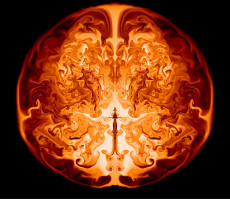Now Available! New Software Catalog
February 9, 2015
by Linda Vu

This image is a slice through the interior of a supermassive star of 55,500 solar masses along the axis of symmetry. It shows the inner helium core in which nuclear burning is converting helium to oxygen, powering various fluid instabilities (swirling lines). This "snapshot" from a CASTRO simulation shows one moment a day after the onset of the explosion, when the radius of the outer circle would be slightly larger than that of the orbit of the Earth around the sun. Visualizations were done in VisIT. (Image Credit: Ken Chen, UCSC)
Researchers in Berkeley Lab’s Computational Research Division (CRD) are renowned for developing and contributing to novel software packages for use in modeling and simulation, computer science and data science. Now, for the first time, all of these tools have been incorporated into a single catalog on the CRD website, where users can easily search and download what they need.
“This catalog represents decades of Berkeley Lab expertise and leadership in applied math, computational science, computer science, data science and technology,” says David Brown, CRD Director. “But the catalog is not only a reflection of what we’ve accomplished, it will also help us identify opportunities for scientific engagement and collaboration with our colleagues at Berkeley Lab, within the Department of Energy and beyond.”
The catalog was compiled by the newly-formed CRD Software Engineering and Management committee, which has representatives from every group in CRD as well as ESnet and NERSC. Dan Gunter, who heads CRD's Integrated Data Frameworks Group, leads the committee. Gunter set up the site with extensive help from Ann Almgren, who is currently Acting Group Lead for the Center for Computational Sciences and Engineering (CCSE) in CRD. The catalog includes diverse offerings from all four departments in the division.
The Applied Mathematics offerings include the BoxLib and Chombo software frameworks for building Adaptive Mesh Refinement (AMR) applications, which have been used to gain insights on topics from turbulent combustion to glacier melt in Antarctica and Greenland. Computer Science software includes Berkeley UPC and GASnet, a high-performance parallel language and underlying networking layer that has been used to speed up simulations in a variety of domains from biology to combustion. The Data Science and Technology software includes VisIt, a widely used interactive, scalable, visualization, animation and analysis tool; and FastBit/FastQuery for indexing of huge scientific data sets that has been used for visualizations of the Laser Wakefield Particle Accelerator.
For more information about CRD software and to download tools, visit: http://crd.lbl.gov/software/.
About Berkeley Lab
Founded in 1931 on the belief that the biggest scientific challenges are best addressed by teams, Lawrence Berkeley National Laboratory and its scientists have been recognized with 16 Nobel Prizes. Today, Berkeley Lab researchers develop sustainable energy and environmental solutions, create useful new materials, advance the frontiers of computing, and probe the mysteries of life, matter, and the universe. Scientists from around the world rely on the Lab’s facilities for their own discovery science. Berkeley Lab is a multiprogram national laboratory, managed by the University of California for the U.S. Department of Energy’s Office of Science.
DOE’s Office of Science is the single largest supporter of basic research in the physical sciences in the United States, and is working to address some of the most pressing challenges of our time. For more information, please visit energy.gov/science.









